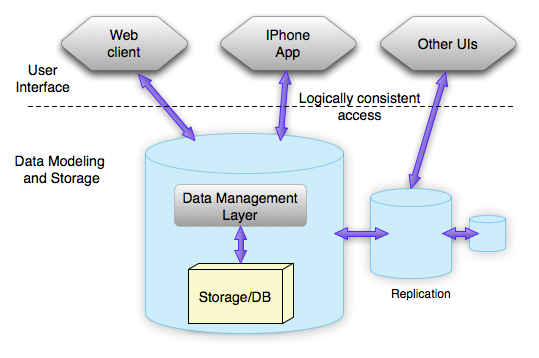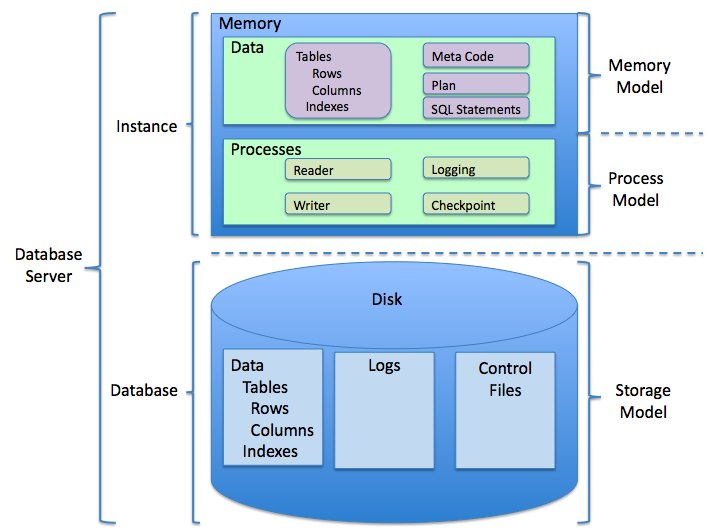Difference Between NoSQL and RDBMS
SQL databases are primarily called Relational Databases, which are known for their tabular structure and with a fixed, pre-determined schema – the logical structure of the data. Database systems have evolved over the years, from the conventional model where data was organized as tables called relations to the more flexible, scalable non-relational database models called NoSQL databases.

What is NoSQL?
While some believe the term NoSQL stands for “non SQL” while many refer to it as “not only SQL.” Either way NoSQL is a non-relational database management system purposely built for specific data models which do not require a pre-defined schema and are easy to scale. It provides a means to store and retrieve data in a way which is different than the traditional tabular format used in relational databases. One of the prominent features of NoSQL database is that no specific schema is required which gives you utmost freedom to store information without even worrying about a schema design. These databases were developed to overcome the limitations of the conventional relational database models. They are focused mainly on two things, high operational speed and flexibility in storing data. These modern databases are founded by top companies such as Amazon, Facebook, and Google.

What is RDBMS?
RDBMS stands for “relational database management system.” For over four decades, relational databases have been the predominant database model used to store data in a structured format, using rows and columns. The limitations in the hierarchical and network databases have led to the development of relational databases model. The structure of the relational database is made of two-dimensional tables, called relations, hence the name. All data and their relations are represented in a tabular format and in addition, it contains the pre-defined system tables required for database operations. They contain descriptive information which can only be queried by users but cannot be manipulated in any way. For example, it displays data in a tabular format just like a spreadsheet, and allows you to view and alter individual values in the table. Relational models are still one of the most used database models till date.
Difference between NoSQL and RDBMS
Schema
– A database schema is the logical view of its structure at its physical level. It represents the logical design of the entire database. It is a container for tables, views and other structural elements. Relational databases require a schema to enable storing of data and it should be defined before adding data to the database. It defines the database structure and relations between them. NoSQL databases, however, take a more liberal approach, operating without a pre-defined schema because unlike relational models, NoSQL databases do not need to define database structure for storing and managing data.
Structure
– Conventional relational database models are table-based meaning they store data in a structured format, using rows and columns. As the name suggests, RDBMS is based on relational model wherein the structure is comprised of relations and highly normalized. The relations help establish connections between tables of data. NoSQL databases, on the other hand, are non-relational database models that operate on the data that have a more complex structure than tables and the information is stored as an aggregate. NoSQL databases are designed to handle unstructured data such as pictures, texts, email, videos, etc.
Scalability
– One of the major problems with relational databases is scalability. They are specifically designed to run on a single server to minimize the issues with distributed computing. They weren’t designed to be able to scale across multiple machines across multiple data centers. Relational databases are vertically scalable and they won’t scale horizontally. NoSQL databases, on the other hand, are horizontally scalable which means by simply adding extra servers they can be able to store enormous amounts of data and they are able to scale on different servers without having to join rows from multiple servers.
Query Speed
– A query requires data which is stored as a single record in a database. In relational database models, data is stored in different tables and you have to join information and add constraints across tables at query time. The database has to evaluate many tables, which reduces the query speed significantly. NoSQL databases, on the other hand, rely on denormalization and try to optimize it accordingly. All the information needed to evaluate the query is stored in a single record, which makes it easy for you to recognize the list of matching records, giving you much better query time.
NoSQL vs. RDBMS: Comparison Chart

Summary of NoSQL vs. RDBMS
Unlike relational databases which are based on relational model, the structure of which is highly normalized, NoSQL databases are based on denormalized data structure which also makes them flexible. NoSQL databases avoid join operations due to complexity issues, which results in better query time. In contrast, NoSQL databases take a different approach because they recognize the importance of operating on data that employ a rather complex structure than tables. In traditional relational models, data is stored in multiple tables and they use joins to integrate necessary data, which reduces the query time significantly. Well, the need to store enormous quantities of data is why NoSQL databases were developed in the first place.
- Difference Between Caucus and Primary - June 18, 2024
- Difference Between PPO and POS - May 30, 2024
- Difference Between RFID and NFC - May 28, 2024
Search DifferenceBetween.net :
Leave a Response
References :
[0]Image credit: https://commons.wikimedia.org/wiki/File:NoSQL_database.png
[1]Image credit: https://commons.wikimedia.org/wiki/File:RDBMS_structure.png
[2]Garcia-Molina, Hector. Database Systems: The Complete Book. Noida, India: Pearson Education India, 2008. Print
[3]Harrington, Jan L. Relational Database Design Clearly Explained. Massachusetts, United States: Morgan Kaufmann Publishers, 2002. Print
[4]Meier, Andreas and Michael Kaufmann. SQL & NoSQL Databases: Models, Languages, Consistency Options and Architectures for Big Data Management. Berlin, Germany: Springer, 2019. Print
[5]Fowler, Adam. NoSQL for Dummies. New Jersey, United States: John Wiley & Sons, 2015. Print
[6]Gaspar, Drazena and Ivica Coric. Bridging Relational and NoSQL Databases. Pennsylvania, United States: IGI Global, 2017. Print
